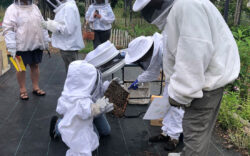Besides beauty and food, plants can provide space from your neighbors, reduce traffic noise and act as cover for discreet summer day-drinking. Hedges, like the famous boxwoods in Sanford Stadium, are well-known, familiar, orderly and often create a formal space. Hedgerows are hedges’ impulsive sister, messy with climbing roses, bushes and intertwined tree limbs. Hedgerows provide animal habitat and a casual garden atmosphere as well as a natural boundary.
If you’re interested in planting perennials for privacy, now is the time to plant or re-pot trees and bushes. You won’t have to water as much during the winter, and it’ll give the plant’s roots time to acclimate. Planting trees in the spring can stress the vegetation, already working hard to produce flowers and leaves. It’s not impossible, just harder on both the flora and the gardener.
I learned about hedgerows watching a BBC history show recreating working farms from the past. Later, I read Craeft: An Inquiry Into the Origins and True Meaning of Traditional Crafts by Alexander Langlands, an archaeologist and one of the presenters on the BBC show. Hedgerows seemed utterly fascinating to me. A boundary—grown by a collection of plants and managed by man—to mark territory, protect livestock and provide privacy.
Looking around Athens, I see more hedges than hedgerows. Athens drivers might see rows of Leyland cypress hedges on Cedar Shoals Drive, Cedar Creek Drive and down Lexington Road. Though the Leyland cypress is a hedge standard, they tend to get thin on the bottom as they grow. No one will see into your second-story window from the street, but drivers will see your kids play in the backyard. Leyland cypress also die from various fungi that chow down on cypress trees planted too closely together in poorly draining soils—the basic formula for most hedges I see. Hollies also are popular for a monoculture hedge.
When I decided to grow my own hedgerow, I went a little crazy, choosing all types of plants at various heights. I added three Leyland cypress to give height in the back, but I planted them far apart. I also included two red maples (“Brandywine” and “October Glory”) and a tulip poplar. Those trees joined several varieties of yucca, a prickly pear, a fragrant tea olive and several crape myrtles. I even planted some rose bushes, moved from a shadier part of the yard. It’ll take three to five years for everything to grow together to make a barrier from the highway, but this first year shows a lot of promise.
Whether you have a yard, a porch or a balcony, it’s worth considering adding some privacy plants. Here’s a few tips from what I’ve learned about maintaining plants for privacy in the last year:
No monoculture: If you have one particularly nasty disease or pest, all your privacy could be gone at once. But you also don’t need one of everything, especially if your design aesthetic is less cottagecore/bric-a-brac and more orderly and formal. You could pick three or four varieties with dark foliage for a sophisticated look.
Vary heights and growing habits: My upright elephant ears (variety “Black Magic”) provide some great height, but not a lot of cover at the bottom. I tested various vines this year, trying to fill the holes between the porch railing, and by midsummer the morning glories were the clear winner. Pick a vine, a medium-sized bush (like a lantana) and a taller specimen, like an elephant ear, for a fun combo on a porch.
Easy watering routine: I have a soaker hose for the hedgerow in the front, but I have to remember to hand water the porch. Accordingly, the porch plants suffer in the summer. For porch plants, limiting the roots will limit the foliage. If you want a bigger top, use a big pot to make room for the roots on the bottom. For in-ground plants, test your soil before planting anything. I killed and sickened a lot of trees for two years in my front yard before I tested the soil and learned I needed to add garden lime and compost.
Experiment with different plants: I saw a balcony garden growing a whole batch of corn this summer. I’m not sure if the gardener harvested any ears, but they did get great privacy from the corn stalks, and this looky-loo’s impressed appraisal.
Like what you just read? Support Flagpole by making a donation today. Every dollar you give helps fund our ongoing mission to provide Athens with quality, independent journalism.









